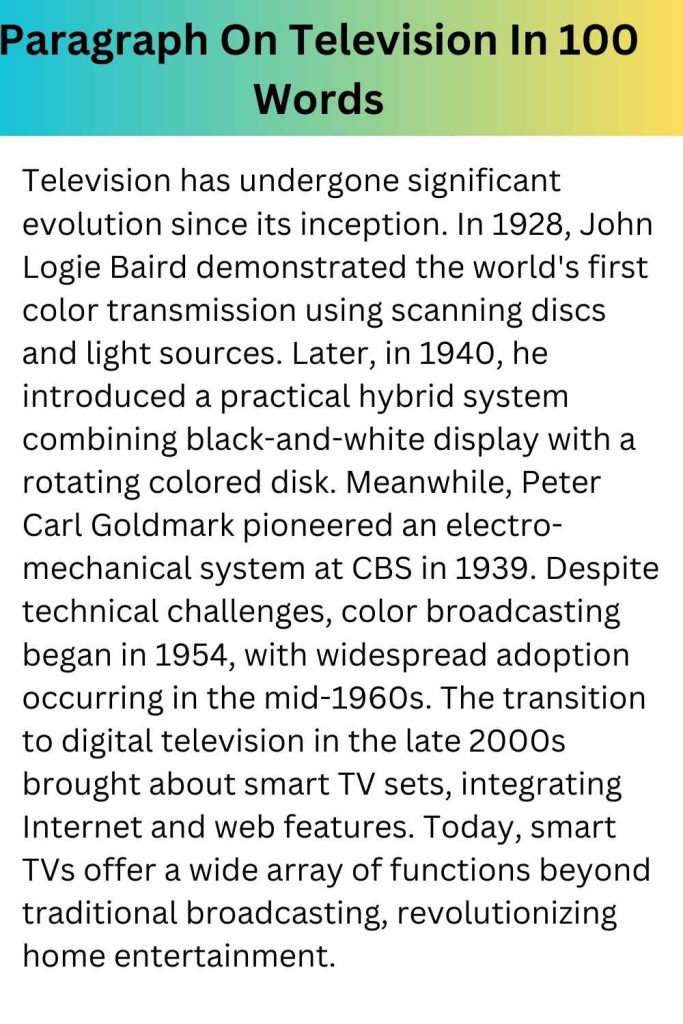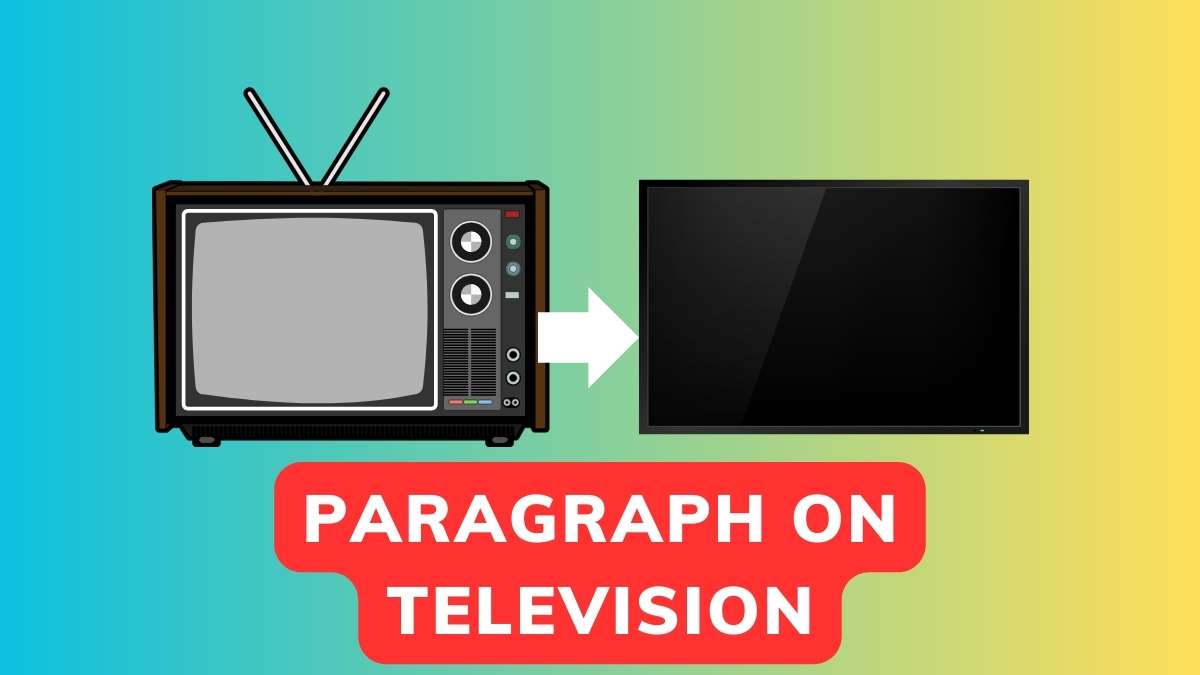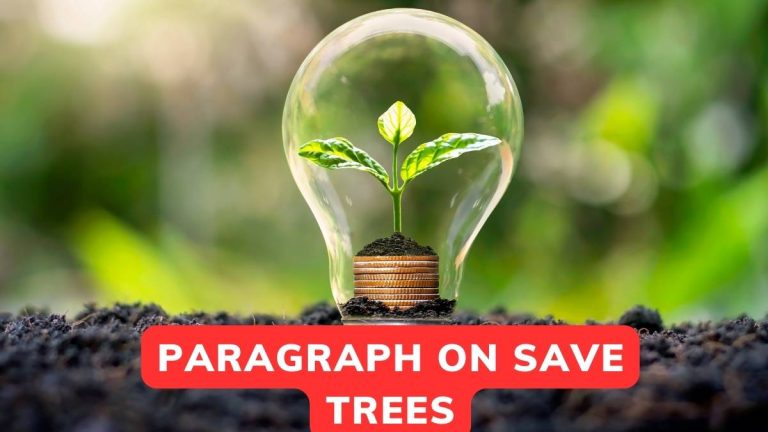Paragraph On Television In English For Class 3-10
Paragraph On Television For Class 3
Television is an amazing invention that allows us to watch shows and learn about the world from the comfort of our homes. It was invented a long time ago by clever people like John Logie Baird and Peter Carl Goldmark. At first, televisions only showed black-and-white pictures, but later on, they became colorful! The first color broadcast happened in 1954, and it took a few years for everyone to have color TVs in their homes. Before that, people watched everything in black and white. Can you imagine that? Now, we have smart TVs that can do even more than just show us programs. They can connect to the internet and let us watch all sorts of things, like videos and movies. So, next time you turn on the TV, remember how it all started and how far it has come.
Paragraph On Television For Class 4
Television, also known as TV, is a fascinating invention that has changed the way we entertain and learn. It is a device that displays moving images and sound, bringing stories, news, and information right into our homes. Did you know that the first color transmission on TV was demonstrated by a Scottish inventor named John Logie Baird in 1928? Television sets have come a long way since then! In the past, TVs used to be bulky and heavy, but now we have sleek and lightweight ones that can even connect to the internet. Color television became popular in the 1960s, and by the 1970s, almost everyone had a color TV in their homes. Today, we have smart TVs that can do much more than just show programs; they can connect to the internet, stream videos, and even play games. Television has become an essential part of our daily lives, providing entertainment and knowledge to people of all ages. So next time you turn on the TV, remember the journey it has taken to become the incredible device it is today!
Paragraph On Television For Class 5
Television is a remarkable invention that has changed the way we see the world. It allows us to watch shows, news, and movies right in our homes. Did you know that the first color transmission was demonstrated by Scottish inventor John Logie Baird in 1928? He used special discs and light sources to create colorful images. Over time, television evolved from mechanical systems to electronic ones. In the 1950s, color broadcasts became more common, and by the 1960s, many people had color TV sets. Today, with digital technology, we have smart TVs that can connect to the internet and show us even more content. Television has come a long way since its early days, bringing entertainment and information to people all around the world.
Paragraph On Television For Class 6
Television has been a remarkable invention that has transformed the way we receive information and entertainment. Developed through decades of innovation and experimentation by inventors like John Logie Baird and companies like RCA and CBS, television has evolved from its early mechanical systems to the digital smart TVs we have today. The first color transmission, demonstrated by Baird in 1928, marked a significant milestone in television history. Over the years, various color systems were introduced, leading to the adoption of the NTSC standard in the United States, allowing for the transmission of color information alongside black-and-white broadcasts. The transition to digital television in the late 2000s brought about even more advancements, enabling features like smart TV capabilities, internet connectivity, and on-demand streaming services. Today, television sets come in various shapes and sizes, offering a wide range of programming options to viewers worldwide. From educational shows to sports events to entertainment programs, television continues to play a vital role in our daily lives, providing us with both information and enjoyment at the touch of a button.
Paragraph On Television For Class 7
Television has played a pivotal role in shaping the way we communicate and entertain ourselves. From its humble beginnings in the early 20th century to the high-definition, digital screens of today, television has undergone remarkable transformations. Scottish inventor John Logie Baird made significant contributions to the development of television, including the world’s first color transmission in 1928. Over the years, various pioneers like Baird and Peter Carl Goldmark introduced different methods to bring color to our screens. The transition from black-and-white to color television sets was a gradual process, with the first color broadcast occurring in 1954. The adoption of digital television in the late 2000s marked another milestone in television technology, allowing for more channels and clearer picture quality. Smart TVs, equipped with internet connectivity and interactive features, have further revolutionized how we consume media. Despite these advancements, television remains a staple in households worldwide, serving as a window to the world and a source of entertainment for people of all ages.
Paragraph On Television For Class 8
Television, a marvel of modern technology, has a fascinating history. Invented by ingenious minds like John Logie Baird and Peter Carl Goldmark, television has evolved significantly over the years. It all began with the first black-and-white transmissions in the late 1920s, paving the way for the introduction of color television in the 1950s. Early television sets were bulky and limited in functionality, but advancements in technology made them more compact and versatile over time. Digital television emerged in the late 20th century, revolutionizing the way we receive and watch TV programs. With the advent of smart TVs, television sets now come equipped with internet connectivity and a plethora of features, offering viewers access to a wide array of content beyond traditional broadcasting. From its humble beginnings to its present-day sophistication, television continues to captivate audiences worldwide, serving as a primary source of entertainment, information, and education.
Paragraph On Television For Class 9
Television, a marvel of modern technology, has revolutionized the way we receive information and entertainment. Invented by Scottish engineer John Logie Baird in the late 1920s, television has undergone remarkable advancements over the years. Initially, television sets were bulky and offered only black-and-white images. However, through the pioneering work of Baird and others, color television became a reality in the 1950s. This technological breakthrough allowed viewers to experience a more vibrant and immersive viewing experience. In the following decades, television sets became more compact and affordable, leading to widespread adoption across the globe. With the advent of digital television in the late 20th century, viewers gained access to a wider range of channels and programming options. Today, smart televisions equipped with internet connectivity offer even greater convenience and flexibility, allowing users to access streaming services and online content with ease. Despite these advancements, television remains a powerful medium for communication, education, and entertainment, shaping our culture and society in profound ways. From the early mechanical systems to the digital age, television continues to evolve, enriching the lives of millions around the world.
Paragraph On Television For Class 10
Television, an invention that revolutionized the way we receive information and entertainment, has a rich history marked by technological advancements. Developed by pioneering inventors like John Logie Baird and Peter Carl Goldmark, television has evolved from mechanical systems to the digital era we live in today. Baird’s early demonstrations in the 1920s laid the groundwork for color transmission, while Goldmark’s electro-mechanical system introduced the concept of color broadcasting. Over the years, television sets became more compact and affordable, leading to widespread adoption across households. The transition to digital television in the late 2000s further expanded its capabilities, paving the way for smart TVs that integrate internet features and streaming services. For students, television serves not only as a source of educational programs but also as a window to the world, offering insights into different cultures, events, and ideas. As television continues to evolve, its impact on society and education remains profound, shaping how we learn and interact with the world around us.
Paragraph On Television In 100 Words
Television has undergone significant evolution since its inception. In 1928, John Logie Baird demonstrated the world’s first color transmission using scanning discs and light sources. Later, in 1940, he introduced a practical hybrid system combining black-and-white display with a rotating colored disk. Meanwhile, Peter Carl Goldmark pioneered an electro-mechanical system at CBS in 1939. Despite technical challenges, color broadcasting began in 1954, with widespread adoption occurring in the mid-1960s. The transition to digital television in the late 2000s brought about smart TV sets, integrating Internet and web features. Today, smart TVs offer a wide array of functions beyond traditional broadcasting, revolutionizing home entertainment.
Paragraph On Television In 100 Words PDF

Paragraph On Television In 150 Words
Television, an essential part of modern life, has a rich history of technological evolution. In the late 1920s, inventors like John Logie Baird pioneered the development of color transmission, laying the groundwork for the vibrant displays we enjoy today. Early television sets were bulky and limited, but advancements in the mid-20th century made color broadcasting more accessible to the public. In the United States, the National Television Systems Committee approved an all-electronic system developed by RCA, which significantly improved picture quality and bandwidth conservation. The transition to digital television in the late 2000s marked another milestone, enabling sharper images and interactive features. Smart TVs, equipped with internet connectivity and on-demand streaming capabilities, have further revolutionized the viewing experience. Despite these advancements, television remains a powerful medium for entertainment, education, and information dissemination, shaping our cultural landscape and connecting people worldwide. As technology continues to evolve, television continues to evolve with it, remaining a ubiquitous presence in households around the globe.
Paragraph On Television In 200 Words
Television, an invention that revolutionized the way we communicate and entertain ourselves, has a rich history marked by technological advancements and societal impact. Scottish inventor John Logie Baird is credited with pioneering many early developments in television technology, including the world’s first color transmission in 1928. Over the years, various inventors and engineers contributed to improving television systems, leading to the introduction of color broadcasting in the 1950s. The transition from black-and-white to color sets was gradual, but by the 1970s, color television had become the norm in households across the world. Digital television, introduced in the late 20th century, further transformed the viewing experience, offering enhanced picture quality and more programming options. The advent of smart televisions brought connectivity and interactivity to the forefront, allowing viewers to access online content and streaming services directly from their TVs. Today, television continues to be a central part of everyday life for billions of people worldwide, providing news, entertainment, and educational programming to audiences of all ages. As technology continues to evolve, the future of television holds the promise of even more immersive and interactive experiences for viewers.







